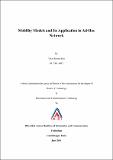| dc.contributor.advisor | Patil, Hemant A. | |
| dc.contributor.advisor | Mulherkar, Jaideep | |
| dc.contributor.author | Jain, Vikas Kumar | |
| dc.date.accessioned | 2017-06-10T14:39:04Z | |
| dc.date.available | 2017-06-10T14:39:04Z | |
| dc.date.issued | 2011 | |
| dc.identifier.citation | Jain, Vikas Kumar (2011). Mobility models and its application in ad-hoc network. Dhirubhai Ambani Institute of Information and Communication Technology, ix, 47 p. (Acc.No: T00308) | |
| dc.identifier.uri | http://drsr.daiict.ac.in/handle/123456789/345 | |
| dc.description.abstract | The Performance of MANET application depends on several parameters like no. of nodes,
node density, communicating traffic pattern, communication range of a node, routing
protocol, battery power of a node, mobility etc. Out these mobility plays an important
role. Mobility model describe the mobility pattern of mobile nodes and users like how their location, velocity, direction and acceleration will change with respect to time. There are some of the mobility models like Random Way Point, Gauss Markov mobility
model, Reference Point Group mobility model and Manhattan mobility model. Since
simulate on plays an important role in conducting the research and to know the performance ofmany MANET applications, hence it is important to choose the appropriate mobility model. Generally, all the simulation work is done by choosing the Random Way Point mobility model because of its simplicity but it is unable to capture a real life scenario. RWP has several limitations so it cannot be applied for each MANET applications. A lot of work has been done by the researchers to design mobility models which are able to capture real life scenario. Accurate realistic modeling is a very challenging task and involves huge efforts. This work intends towards proposing a method to answer about best fit mobility model for the given trace along with confidence level and parameters values of the model. If we use best fit mobility model according to the given trace then accuracy of the results will improve. This work mainly focuses on RWP and RPGM mobility model. Also the proposed method are applied on a ad hoc wireless sensor network application called Zebra Net trace, to answer about the best fit mobility model out of RWP and RPGM. | |
| dc.publisher | Dhirubhai Ambani Institute of Information and Communication Technology | |
| dc.subject | Wireless LANs | |
| dc.subject | Mobile computing | |
| dc.subject | Mobile communication systems | |
| dc.subject | Mobile communication systems | |
| dc.subject | Mathematical models | |
| dc.subject | Network Architecture and Design | |
| dc.subject | Mobility model | |
| dc.subject | Electric network topology | |
| dc.classification.ddc | 621.3821 JAI | |
| dc.title | Mobility models and its application in ad-hoc network | |
| dc.type | Dissertation | |
| dc.degree | M. Tech | |
| dc.student.id | 200911012 | |
| dc.accession.number | T00308 | |

